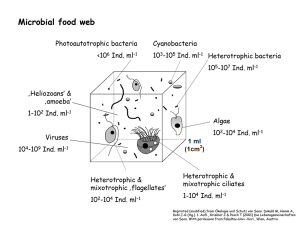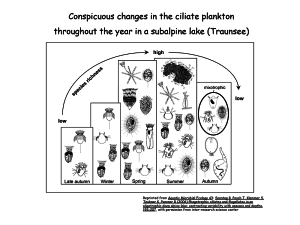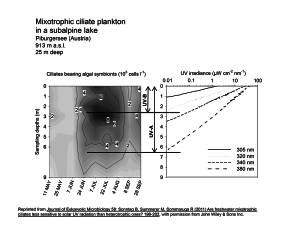Microbial food web
In lake plankton, we find many diverse organisms that belong to an aquatic community that is essential for natural processes. Members of this food web are unicellular algae, so-called ‘flagellates’ and ciliates but also bacteria and millimeter-sized rotifers or crustaceans (e.g. copepods, water fleas). All these organisms network tightly and, for example, crustaceans feed on algae, rotifers on ciliates, ciliates on algae or bacteria, larger ciliates on smaller ciliates and so on. Moreover, many different symbioses are found such as between ciliates and algae where the latter provide photosynthetic products or even sunscreen compounds to their hosts.
Annual ciliate plankton cycle
Throughout an annual cycle, we find varying ciliate communities dependent on temperature, oxygen availability, nutrients etc. Interestingly, at times of the highest incident solar radiation a specific ciliate assemblage is dominant – the so-called mixotrophic ciliates that live in symbiosis with unicellular algae (or their chloroplasts). These ciliates are perfectly adapted to the UV radiation in a lake (see below).
Mixotrophic ciliate plankton
Spatial distribution of algal-bearing ciliates in the upper 9 m of the water column (left) and underwater UV radiation measured at four nominal wavelengths (right). The horizontal upper line between graphs indicates the lower boundary of UV-B and the lower line that of UV-A penetration.
These so-called mixotrophic ciliates prevail in the depths according to the UV-flooded lake area assuming that they were well equipped with sunscreens such as MAAs as verified in several of these species.
Download Figure as PDF




